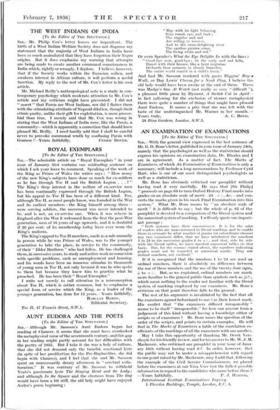AN EXAMINATION OF EXAMINATIONS
[To the Editor of THE SPECTATOR.] Sm,—With the general view expressed in the last sentence of Mr. G. D. Bone's letter, published in your issue of January 24th, namely that the psychologist as well as the statistician should express his opinions on examination data, Dr. Rhodes and I are in agreement. As a matter of fact, The Marks of Examiners, of which An Examination of Examinations is only a summary, will include a long memorandum by Professor Cyril Burt, who is one of our most distinguished psychologists as well as a statistician.
Mr. Bone has obviously criticised our pamphlet without having read it very carefully. He says that [Sir Philip] " proceeds on page 64 to turn Oxford History Final marks into grades on an absolute scale of merit-24=a-f-, &c.—and con- verts the marks given in his mock Final Examination into this system." What Mr. Bone means by " an absolute scale of merit " it is difficult to say ; but the whole of p. 62 of tho pamphlet is devoted to a comparison of the literal system and the numerical system of marking. I will only quote one import- ant passage :
" Both systems have their conveniences. It is for the sake of readers who are unaccustomed to literal marking, and to enable them to estimate by what number of grades (or subordinate classes) any two examiners differ, that we have attributed the numbers 1 to 24 to the successive grades 8 to a+, and that, side by side with the literal tables, we have inserted numerical tables on this basis. But, for the reasons stated above, the numbers indicating grades must not be regarded as numerical marks. They are ordinal numbers, not cardinal."
If it is recognised that the numbers 1 to 24 arc used as ordinal numbers, there is absolutely no difference between the use of these numbers and the use of the twenty-four signs. 8 to a+. But, as we explained, ordinal numbers are much more familiar to the general public than symbols such as 0-7-, which mean nothing to the reader not familiar with the literal system of marking employed by our examiners. Mr. Bone's criticism on that point therefore falls to the ground.
The rest of his argument is invalidated by the fact that all the examiners agreed beforehand to use 8 as their lowest mark.
His verdict that " the examiners differed irresponsibly " seems to be itself " irresponsible," for how can anyone form a judgement of this kind without having a knowledge either of scripts or of examiners ? Mr. Bone raises the question of the order of the scripts, and points to certain examples. He will find in The Marks of Examiners a table of the correlation co- efficients of the markings of all the examiners with one another.
May I take this opportunity of thanking Mr. Derek Vers- choyle for his friendly review, and for his answer to Mr. W. J. M.
Mackenzie, who criticised our pamphlet in your issue of Janu- ary 10th without having read it ? In order, however, that the public may not be under a misapprehension with regard to one point raised by Mr. Mackenzie, may I add that, following the example of the Civil Service Commissioners, we placed before the examiners at our Viva Voce test the fullest possible information in regard to the candidates who came before them
—Yours faithfully, P. J. HARTOG. International Institute Examinations Inquiry, i•Plowclen Buildings, Temple, London, E.G. 4.














































 Previous page
Previous page